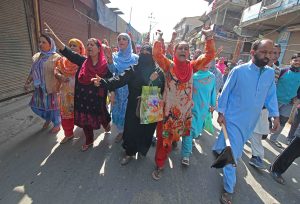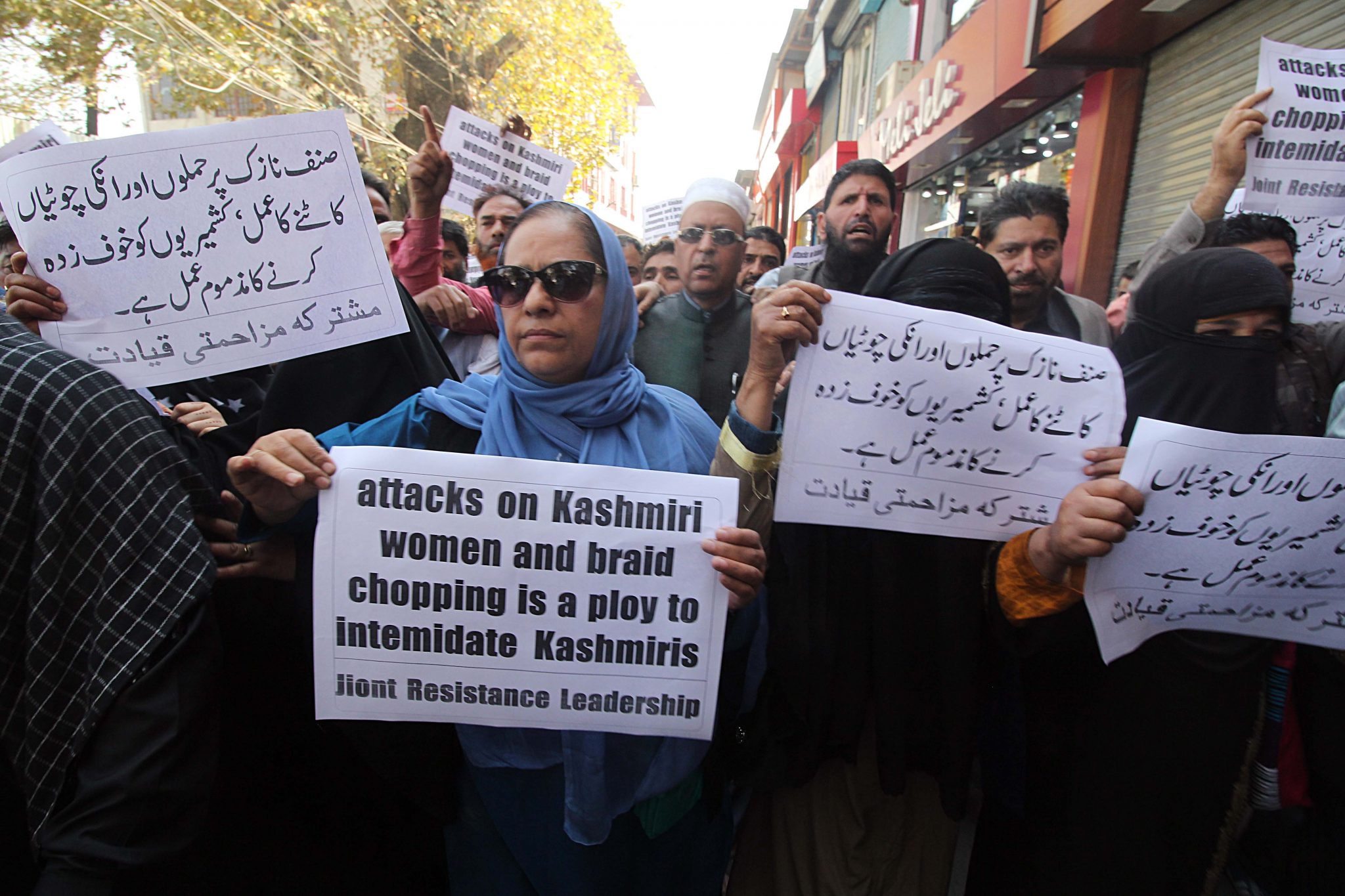by Mohd Tahir Ganie, PhD candidate at IICRR, Tweets @TahirFiraz
On a recent field trip to Kashmir, I witnessed a strange thing: every other day since early September, women’s braids were being mysteriously clipped by some unknown entity, leaving them, and the people around, in utter shock and disgust. Within a month some 100 cases of braid-clipping have been reported. On 6th Oct, one elderly man died by brick in south Kashmir after being mistaken for a braid-clipper. And, as the police in Kashmir fail to get a breakthrough, some people have grown suspicious that it might be state ‘agencies’ doing all this.
On its part, the police have doubled the reward money to 600,000 Indian rupees for any one giving information, and have said that they will “seriously investigate the role of anti-national elements who seem to be getting benefited by the protests triggered by the acts of mysterious hair cutting.” However, for the People’s Democratic Party (PDP), which rules the restive Jammu and Kashmir in (unpopular) coalition with the Hindu right-wing Bhartiya Janata Party (BJP), the challenge seems to grow bigger as incidents of braid-clipping spike. After brutally quelling the 2016 anti-India protests and largely managing the tumultuous period of the early 2017, the ruling party had started public outreach campaign to regain foothold in its constituencies, but now it appears to be staring at a possible political crisis. Already, a large number of women have hit the streets while as the pro-independence groups gave a successful call for one-day strike on 9th October against what one senior pro-independence leader termed as “assault on the dignity of our womenfolk”; clashes broke out between police and protestors at various places, leading to injuries. The pro-Independence groups framed the braid-clipping issue as a gambit of the Indian government to weaken the on-going political struggle against Indian rule which had suddenly intensified in the summer of 2016. In a conflict zone like Kashmir, a small spark like this has potential to create a big political firestorm and PDP knows it from experience. But every one seems to be at lost about who is behind these braid-clipping assaults.

In its hard-hitting 10th Oct editorial, the Valley’s largest circulating daily Greater Kashmir wrote, “It is intriguing, in a state with over dozen intelligence agencies operating, the administration is clueless about what is happening here. It is high time for the government to gear up its law enforcing agencies and resolve the mystery. The valley deserves restoration of normality on this count. If this thing spirals out of control it can spawn elements that will deeply hurt this society, and that hurt will have repercussions on everything, including politics.” Some people believe it might be state ‘agencies’ doing it and their suspicion seems to stem from past experience. Because the state has employed such tactics—seemingly as part of its anti-insurgency measure—to create fear psychosis among the local population. For example, in his essay ‘Dreading the Night,’ young Kashmiri journalist Zahid Rafiq narrates how in the mid-1990’s Kashmir, a certain ‘witch’ ran riot, scaring hell out of the people, but was ultimately found to be a psy-op. It was the time, wrote Zahid, when “Everyone in the neighborhood started sleeping with hammers, axes, and knives.” Exactly same is happening now. As The Guardian reported (11 Oct), “Vigilante groups armed with axes and wooden boards have been formed in some neighbourhoods in response to the alleged attacks. At least 12 people, including the tourists, have required police to rescue them from mobs.”
But, prior to this wave sweeping the Kashmir valley, over 1000 braid-clipping cases were reported from different parts of northern India for which, like in Kashmir, nobody could be prosecuted. Thus, the mystery only continues in Kashmir, unresolved. In every house hold in Kashmir conspiracy theories abound now. I heard at least three:
“This must be their [government’s] ploy to lure the militants out from their hideouts,” said a young man working at a pharmacy, “As they [militants] will feel duty bound to help people against the braid-choppers.” He told me that businesses have suffered because people avoid venturing out of their homes.
“I am sure government is doing it,” said a man in his late 50’s, “after last year’s turmoil police’s entry to rural areas had become difficult, but now people need police, they will be received in rural areas. Earlier policemen had threat to go there.”
Another theory went like this: people would have resisted installation of CCTV cameras but now they will cooperate as they are scarred and desperately want to nab the braid-clippers. Thus, army’s work is made easier, once CCTV’s are put everywhere, they can keep track of every movement.One militant group also issued an audio message telling people not to fall into the government’s trap of making people paranoid of strangers which would eventually make them lock their doors and not shelter any militant in their homes.
These beliefs or misconceptions have their context. After the death of young rebel leader Burhan Wani in July 2016, many young men in Kashmir had taken up arms. To counter the surging ranks of pro-independence militants, the hardline ruling dispensation at New Delhi launched the ‘Operation All-Out’ in June last year targeting over 250 active militants of different groups. Within eight months of 2017, some 132 militants, including high profile Sabzar Bhat and Abu Dujana, were killed by Indian soldiers in different, but regular, gun fights. To stop further losses, the militants broke their sim cards—through which they were tracked down by the army—and went into hiding. However, New Delhi is adamant to hunt them down. Whatever be the truth and purpose behind braid-clipping phenomenon, it has certainly induced fear, paranoia among people, and made them angry and agitated. But, it has also provided opportunity to pro-independence groups to mobilize people as could be seen on 9th Oct. Thus, how the whole issue will unfold politically is to be seen, though events so far suggest that it may potentially lead to another bout of unrest and violence—as sporadic clashes between police and protestors have already been reported at different places of Kashmir.
All photos by Srinagar-based photojournalist Faisal Khan.
Notes:
http://brinkmag.org/2013/05/01/dreading-the-night/




